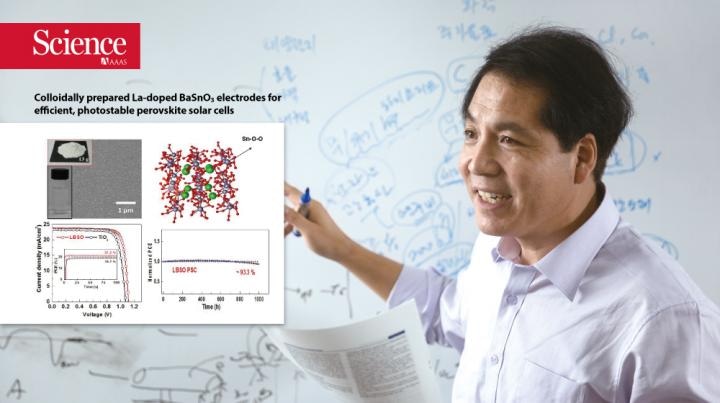Apr 3 2017
 This is the distinguished Prof. Sang-Il Seok of Energy and Chemical Engineering at UNIST. (Credit - Photo by Hong Beom Ahn, Design by HyeJee Park)
This is the distinguished Prof. Sang-Il Seok of Energy and Chemical Engineering at UNIST. (Credit - Photo by Hong Beom Ahn, Design by HyeJee Park)
A recent research affiliated with UNIST has revealed a new economical way to manufacture inorganic-organic hybrid perovskite solar cells (PSCs) which sets a new world-record efficiency performance, particularly in photostability. The research team visualizes that this technique and platform will drastically add to the acceleration of commercialization of PCSs.
This innovative research has been conducted by Distinguished Professor Sang-Il Seok of Energy and Chemical Engineering at UNIST in collaboration with Dr. Seong Sik Shin and Dr. Jun Hong Noh of Korea Research Institute of Chemical Technology (KRICT). Their results can be found online in the March issue of the acclaimed journal Science. The research has emerged as the most capable candidate for the next generation of high efficiency solar cell technology.
PSCs are composed of a mixture of inorganic elements and organic molecules within a single crystalline structure, that together trap light and change it into electricity. It is a unique crystal structures, comprising of one anion and two cations. They can be fabricated easily and inexpensively compared to silicon-based solar cells, and on a rigid and flexible substrate. Furthermore, PSCs accomplishing a photovoltaic efficiency of 22.1%, comparable to that of single crystalline silicon solar cells (25%), have been attracting a lot of attention as the next-generation solar cells.
Professor Seok, as top scientist in the field, has guided PSC technology. This success is based on the earlier works (new architecture, composition, and process for PSCs) of Professor Sang-Il Seok.
In this research, the team reported the fabrication of PSCs fulfilling both high efficiency (21.2%) and high photostability of the perovskite solar cells with photoelectrode materials (Lanthanum (La)-doped BaSnO3 (LBSO)) synthesized by a highly novel technique under very mild conditions (below 200 °C). They employed methylammonium lead iodide (MAPbI3) peorvskite materials for PSCs.
Photostability can be defined as the ability to endure exposure to light without serious degradation. This new material produced by Professor Seok's research team can also retain 93% of its original performance even after 1,000 hours of exposure to sunlight. The synthesis of the photoelectrode material can also be done at less than 200 °C, which is a lot lower than that of conventional (high temperature over 900 °C), making fabrication much simpler.
The research team has also suggested a new solar cell manufacturing methodology, called 'Hot-Pressing Method'. This method firmly adheres two objects by applying pressure and temperature. It allows the manufacture of high efficiency, economical and stable perovskite solar cells.
This study combines the newly-synthesized photoelectrode material and the hot-pressing method to lower the manufacturing cost to less than half of the existing silicon solar cells. This study helped us realize PSCs with a steady-state power conversion efficiency of 21.2% and excellent photostability. This achievement, realized by the unique technology of domestic researchers, has surpassed the conventional low-efficiency and stability limit of next-generation solar cell technology.
Professor Sang-Il Seok, Energy and Chemical Engineering, UNIST
The research has been supported by Global Frontier R&D Program for Multiscale Energy System, Climate Change Program, and Wearable Platform Materials Technology Center through the National Research Foundation of Korea (NRF), funded by the Ministry of Science, ICT and Future Planning.
Journal Reference
Seong Sik Shin, et al., “Colloidally prepared La-doped BaSnO3 electrodes for efficient, photostable perovskite solar cells,” Science, (2017).